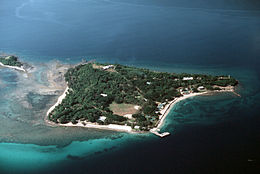Grande Island
| Fort Wint | |
|---|---|
| Grande Island, Philippines | |
| Part of Harbor Defenses of Manila and Subic Bays | |

Fort Wint (Grande Island)
|
|
| Coordinates | 14°46′10.77″N 120°13′40.30″E / 14.7696583°N 120.2278611°ECoordinates: 14°46′10.77″N 120°13′40.30″E / 14.7696583°N 120.2278611°E |
| Site information | |
| Controlled by | United States |
| Garrison information | |
| Garrison | 60th Coast Artillery (AA) |
Fort Wint (known as Grande Island, the Philippines) was part of the harbor defenses of Manila and Subic Bays built by the Philippine Department of the United States Army between 1907 and 1920 in response to recommendations of the Taft Board prior to the non-fortification clause of the Washington Naval Treaty. Fort Wint was located on Grande Island at the entrance of Subic Bay, approximately 35 miles (56 km) north of Manila Bay. The fort was named for Brigadier General Theodore J. Wint. As specified in the National Defense Act of 1935, this was one of the locations where coastal artillery training was conducted. A battery of the 60th Coast Artillery (AA) was stationed here.
Fort Wint was armed with fourteen Taft-Endicott period coast artillery pieces mounted in five batteries. Battery Warwick contained the fort's most powerful weaponry, two 10-inch gun M1895 disappearing guns on Buffington-Crozier carriages. Batteries Hall and Woodruff each mounted two 6-inch M1905 guns also on disappearing carriages. Batteries Flake and Jewell were armed with 3-inch gun M1903 on pedestal mounts. As with other forts of the same period, the weaponry of Fort Wint was obsolete at the outbreak of hostilities with Japan in 1941.
Within weeks of the U.S. entry into World War II, Fort Wint was ordered abandoned and its crews reassigned to other American positions in Manila Bay. Consequently, the fort played no part in the subsequent siege of the island forts. Fort Wint was recaptured by U.S. forces in March 1945. Fort suffered substantial damage during the campaign to retake the Philippines .
Grande Island and the remains of Fort Wint were incorporated into the U.S. Naval Base Subic Bay. The two 10-inch (25-cm) disappearing guns of Battery Warwick were dismantled by the United States Navy in the 1960s and shipped to Fort Casey for renovation and display. The four 3-inch guns of Batteries Flake and Jewell were removed and divided between Forts Flagler and Casey in Washington state where they remain on display. The 6-inch guns of Battery Hall remain in place (pictures right). Grand Island was developed into a resort following the closure of the Subic Naval Base in 1992.
...
Wikipedia
